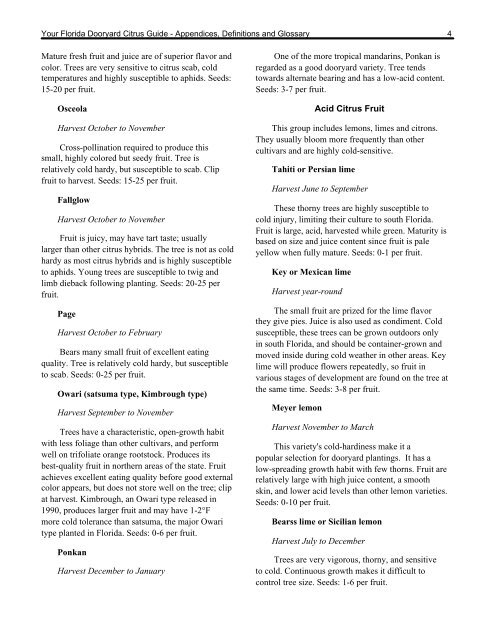Dooryard Citrus Guide - Appendices, Definitions and Glossary
Dooryard Citrus Guide - Appendices, Definitions and Glossary
Dooryard Citrus Guide - Appendices, Definitions and Glossary
Create successful ePaper yourself
Turn your PDF publications into a flip-book with our unique Google optimized e-Paper software.
Your Florida <strong>Dooryard</strong> <strong>Citrus</strong> <strong>Guide</strong> - <strong>Appendices</strong>, <strong>Definitions</strong> <strong>and</strong> <strong>Glossary</strong> 4<br />
Mature fresh fruit <strong>and</strong> juice are of superior flavor <strong>and</strong><br />
color. Trees are very sensitive to citrus scab, cold<br />
temperatures <strong>and</strong> highly susceptible to aphids. Seeds:<br />
15-20 per fruit.<br />
Osceola<br />
Harvest October to November<br />
Cross-pollination required to produce this<br />
small, highly colored but seedy fruit. Tree is<br />
relatively cold hardy, but susceptible to scab. Clip<br />
fruit to harvest. Seeds: 15-25 per fruit.<br />
Fallglow<br />
Harvest October to November<br />
Fruit is juicy, may have tart taste; usually<br />
larger than other citrus hybrids. The tree is not as cold<br />
hardy as most citrus hybrids <strong>and</strong> is highly susceptible<br />
to aphids. Young trees are susceptible to twig <strong>and</strong><br />
limb dieback following planting. Seeds: 20-25 per<br />
fruit.<br />
Page<br />
Harvest October to February<br />
Bears many small fruit of excellent eating<br />
quality. Tree is relatively cold hardy, but susceptible<br />
to scab. Seeds: 0-25 per fruit.<br />
Owari (satsuma type, Kimbrough type)<br />
Harvest September to November<br />
Trees have a characteristic, open-growth habit<br />
with less foliage than other cultivars, <strong>and</strong> perform<br />
well on trifoliate orange rootstock. Produces its<br />
best-quality fruit in northern areas of the state. Fruit<br />
achieves excellent eating quality before good external<br />
color appears, but does not store well on the tree; clip<br />
at harvest. Kimbrough, an Owari type released in<br />
1990, produces larger fruit <strong>and</strong> may have 1-2°F<br />
more cold tolerance than satsuma, the major Owari<br />
type planted in Florida. Seeds: 0-6 per fruit.<br />
Ponkan<br />
Harvest December to January<br />
One of the more tropical m<strong>and</strong>arins, Ponkan is<br />
regarded as a good dooryard variety. Tree tends<br />
towards alternate bearing <strong>and</strong> has a low-acid content.<br />
Seeds: 3-7 per fruit.<br />
Acid <strong>Citrus</strong> Fruit<br />
This group includes lemons, limes <strong>and</strong> citrons.<br />
They usually bloom more frequently than other<br />
cultivars <strong>and</strong> are highly cold-sensitive.<br />
Tahiti or Persian lime<br />
Harvest June to September<br />
These thorny trees are highly susceptible to<br />
cold injury, limiting their culture to south Florida.<br />
Fruit is large, acid, harvested while green. Maturity is<br />
based on size <strong>and</strong> juice content since fruit is pale<br />
yellow when fully mature. Seeds: 0-1 per fruit.<br />
Key or Mexican lime<br />
Harvest year-round<br />
The small fruit are prized for the lime flavor<br />
they give pies. Juice is also used as condiment. Cold<br />
susceptible, these trees can be grown outdoors only<br />
in south Florida, <strong>and</strong> should be container-grown <strong>and</strong><br />
moved inside during cold weather in other areas. Key<br />
lime will produce flowers repeatedly, so fruit in<br />
various stages of development are found on the tree at<br />
the same time. Seeds: 3-8 per fruit.<br />
Meyer lemon<br />
Harvest November to March<br />
This variety's cold-hardiness make it a<br />
popular selection for dooryard plantings. It has a<br />
low-spreading growth habit with few thorns. Fruit are<br />
relatively large with high juice content, a smooth<br />
skin, <strong>and</strong> lower acid levels than other lemon varieties.<br />
Seeds: 0-10 per fruit.<br />
Bearss lime or Sicilian lemon<br />
Harvest July to December<br />
Trees are very vigorous, thorny, <strong>and</strong> sensitive<br />
to cold. Continuous growth makes it difficult to<br />
control tree size. Seeds: 1-6 per fruit.
















